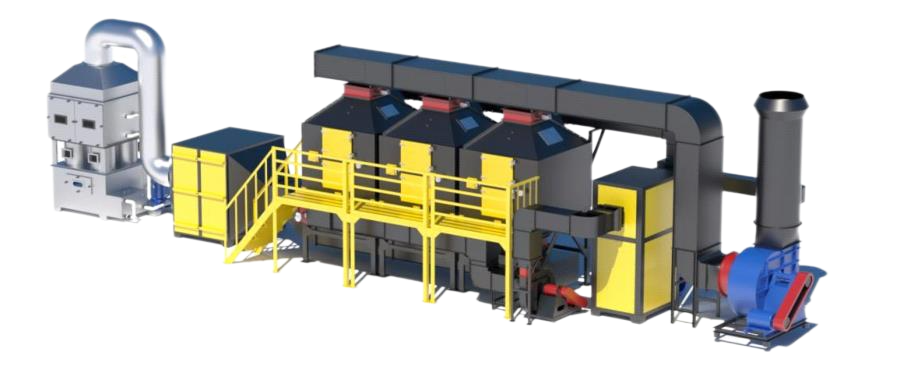Catalytic combustion
Release Date:2023-09-15 Number of views:1703
Adsorption and concentration + catalytic combustion (CO) combined equipment

Working principle
The suction attachment + catalytic combustion equipment is developed on the basis of the adsorption device with only a single adsorption performance. The desadsorption regeneration device is added to ensure that the adsorbent can be reused, aiming at reducing the replacement times of live adsorbent and the cost of hazardous waste treatment in the later period. Activated carbon or zeolite can be used as adsorbent, mainly based on the adsorption performance of adsorbent and the properties of organic matter to absorb and strip, the waste gas is taken into the catalytic combustion furnace, and the organic waste gas is oxidized into CO ₂ + H ₂ O at the high temperature of 300-400°.
CnHm + (n + m / 4) + O₂ 300-400 ° nCO ₂ + m / ₂ H ₂ O + heat catalytic agent

Pretreatment: because the adsorbent is full of porous structure, such as excessive large particles in the exhaust gas, it will block the gap, causing the adsorbent to can not absorb the waste gas and lose the most basic function; so the front-end pretreatment is an important part of the adsorption concentration + catalytic combustion equipment. Dry filter as one of the pretreatment methods; generally using two-stage filtration, primary filter + medium effect bag filter; recommended particulate content of 1mg / m³. The organic waste gas to be treated is drawn from the air duct and enters the dry filter, which can filter the particulate matter and sticky components in the waste gas, and the purification effect can reach more than 95%. In order to improve the adsorption effect of activated carbon and prolong the adsorption cycle and service life of activated carbon. According to the working conditions, matching water spray can be selected to improve the purification effect of pretreatment and reduce the consumables of the dry filter.
Adsorption gas process: using the physical characteristics of adsorbent adsorption of VOC organic waste gas, and honeycomb adsorbent large surface area, strong adsorption capacity characteristics, the organic waste gas adsorption into the activated carbon pores, so that the gas purification, purification of gas through the fan emptying, achieve the effect of organic waste gas treatment;
Desorption gas process: when the adsorption micropore adsorption saturation to a certain time, can no longer be adsorption, and then use the high temperature hot air produced by the catalytic bed to desorption of the adsorbent, the organic matter in the adsorbent micropore automatically separated from the activated carbon after high temperature, so that the adsorbent regeneration. The organic matter has been concentrated (concentration dozens of times higher than the original) and was sent to the catalytic combustion chamber for catalytic combustion, catalytic oxidation at 300~400℃, make it into harmless CO ₂ and H ₂ O discharge, when the organic waste gas concentration reached 2000mg / m³, organic waste gas in the catalytic bed can maintain spontaneous combustion, without another heating, combustion exhaust directly into the atmosphere, which can meet the combustion and stripping heat energy, and can achieve the purpose of energy saving, regeneration of activated carbon can be used for the next adsorption.
High-temperature catalytic combustion process: the catalytic combustion furnace uses the catalyst to change the reaction conditions to achieve the combustion of organic matter at a lower temperature, so that it becomes CO ₂ + H ₂ O. The essence of the gas-solid phase catalytic reaction in the catalytic combustion furnace is the participation of reactive oxygen species in deep oxidation. In the process of catalytic purification, the catalyst used to reduce the activation energy of chemical reaction, make the reaction conditions more conducive to can control conditions, with the help of the catalyst makes the waste gas in lower temperature condition, no flame combustion, and its oxidation decomposition into harmless CO ₂ + H ₂ O, at the same time release a lot of heat, so as to achieve the purpose of removing harmful waste gas. The internal device is mainly composed of shell, heat exchanger, heating wire, precious metal and so on.
Suction attached + catalytic combustion (CO) combination equipment using double air continuous work, large workload only design multiple adsorption bed use, a catalytic combustion chamber, under the action of induced fan, adsorption bed adsorption of exhaust gas in the airflow, when adsorbent fast reach saturated adsorption bed at the ends of the closed valve closed at the same time, namely stop adsorption work, to stripping process. The processing equipment is suitable for enterprises with continuous production.
Product characteristics
1. High purification efficiency;
2. Long service life of the catalyst;
3. Convenient loading of adsorbent;
4. Smooth air flow and small wind resistance;
5. High degree of automatic control, multiple safety protection measures, abnormal alarm system;
6. Intermittent compensation heating, energy saving and consumption reduction;
7. When the organic waste gas reaches 2000mg / m³, it can maintain the natural nature.
Applications

Adsorption and concentration + catalytic combustion (CO) combined equipment

Working principle
The suction attachment + catalytic combustion equipment is developed on the basis of the adsorption device with only a single adsorption performance. The desadsorption regeneration device is added to ensure that the adsorbent can be reused, aiming at reducing the replacement times of live adsorbent and the cost of hazardous waste treatment in the later period. Activated carbon or zeolite can be used as adsorbent, mainly based on the adsorption performance of adsorbent and the properties of organic matter to absorb and strip, the waste gas is taken into the catalytic combustion furnace, and the organic waste gas is oxidized into CO ₂ + H ₂ O at the high temperature of 300-400°.
CnHm + (n + m / 4) + O₂ 300-400 ° nCO ₂ + m / ₂ H ₂ O + heat catalytic agent

Pretreatment: because the adsorbent is full of porous structure, such as excessive large particles in the exhaust gas, it will block the gap, causing the adsorbent to can not absorb the waste gas and lose the most basic function; so the front-end pretreatment is an important part of the adsorption concentration + catalytic combustion equipment. Dry filter as one of the pretreatment methods; generally using two-stage filtration, primary filter + medium effect bag filter; recommended particulate content of 1mg / m³. The organic waste gas to be treated is drawn from the air duct and enters the dry filter, which can filter the particulate matter and sticky components in the waste gas, and the purification effect can reach more than 95%. In order to improve the adsorption effect of activated carbon and prolong the adsorption cycle and service life of activated carbon. According to the working conditions, matching water spray can be selected to improve the purification effect of pretreatment and reduce the consumables of the dry filter.
Adsorption gas process: using the physical characteristics of adsorbent adsorption of VOC organic waste gas, and honeycomb adsorbent large surface area, strong adsorption capacity characteristics, the organic waste gas adsorption into the activated carbon pores, so that the gas purification, purification of gas through the fan emptying, achieve the effect of organic waste gas treatment;
Desorption gas process: when the adsorption micropore adsorption saturation to a certain time, can no longer be adsorption, and then use the high temperature hot air produced by the catalytic bed to desorption of the adsorbent, the organic matter in the adsorbent micropore automatically separated from the activated carbon after high temperature, so that the adsorbent regeneration. The organic matter has been concentrated (concentration dozens of times higher than the original) and was sent to the catalytic combustion chamber for catalytic combustion, catalytic oxidation at 300~400℃, make it into harmless CO ₂ and H ₂ O discharge, when the organic waste gas concentration reached 2000mg / m³, organic waste gas in the catalytic bed can maintain spontaneous combustion, without another heating, combustion exhaust directly into the atmosphere, which can meet the combustion and stripping heat energy, and can achieve the purpose of energy saving, regeneration of activated carbon can be used for the next adsorption.
High-temperature catalytic combustion process: the catalytic combustion furnace uses the catalyst to change the reaction conditions to achieve the combustion of organic matter at a lower temperature, so that it becomes CO ₂ + H ₂ O. The essence of the gas-solid phase catalytic reaction in the catalytic combustion furnace is the participation of reactive oxygen species in deep oxidation. In the process of catalytic purification, the catalyst used to reduce the activation energy of chemical reaction, make the reaction conditions more conducive to can control conditions, with the help of the catalyst makes the waste gas in lower temperature condition, no flame combustion, and its oxidation decomposition into harmless CO ₂ + H ₂ O, at the same time release a lot of heat, so as to achieve the purpose of removing harmful waste gas. The internal device is mainly composed of shell, heat exchanger, heating wire, precious metal and so on.
Suction attached + catalytic combustion (CO) combination equipment using double air continuous work, large workload only design multiple adsorption bed use, a catalytic combustion chamber, under the action of induced fan, adsorption bed adsorption of exhaust gas in the airflow, when adsorbent fast reach saturated adsorption bed at the ends of the closed valve closed at the same time, namely stop adsorption work, to stripping process. The processing equipment is suitable for enterprises with continuous production.
Product characteristics
1. High purification efficiency;
2. Long service life of the catalyst;
3. Convenient loading of adsorbent;
4. Smooth air flow and small wind resistance;
5. High degree of automatic control, multiple safety protection measures, abnormal alarm system;
6. Intermittent compensation heating, energy saving and consumption reduction;
7. When the organic waste gas reaches 2000mg / m³, it can maintain the natural nature.
Applications

- Previous post:There is no
- Next post:There is no



